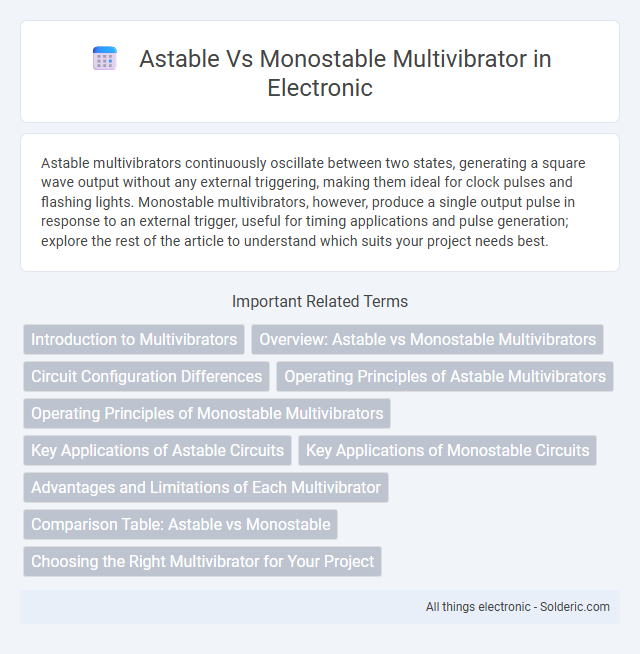Astable multivibrators continuously oscillate between two states, generating a square wave output without any external triggering, making them ideal for clock pulses and flashing lights. Monostable multivibrators, however, produce a single output pulse in response to an external trigger, useful for timing applications and pulse generation; explore the rest of the article to understand which suits your project needs best.
Comparison Table
| Feature | Astable Multivibrator | Monostable Multivibrator |
|---|---|---|
| Operation Mode | Free-running oscillator | One-shot pulse generator |
| Output States | Continuous oscillation between high and low | Single output pulse per trigger |
| Trigger Requirement | No external trigger needed | Requires external trigger to start pulse |
| Output Waveform | Square wave (continuous) | Single pulse (fixed duration) |
| Pulse Duration Control | Determined by RC time constants (oscillation period) | Duration set by RC time constant (pulse width) |
| Common Applications | Clock signals, LED blinkers, tone generators | Timers, pulse width modulators, switch debouncing |
| Stability | Continuous output, frequency set by components | Stable single pulse, pulse duration adjustable |
Introduction to Multivibrators
Multivibrators are electronic circuits used to generate rectangular waveforms and operate in different modes, with astable and monostable being primary types. An astable multivibrator continuously oscillates between its two unstable states, producing a periodic square wave without any external triggering. In contrast, a monostable multivibrator has one stable state and switches to its unstable state only when triggered, returning to stable automatically after a fixed time interval.
Overview: Astable vs Monostable Multivibrators
Astable multivibrators generate continuous square wave oscillations without any external triggering, making them ideal for clock pulse generation and blinking LEDs. Monostable multivibrators produce a single output pulse of fixed duration when triggered, suitable for applications requiring precise timing intervals such as timers or pulse generation. Your choice between astable and monostable depends on whether you need continuous oscillations or single pulse outputs.
Circuit Configuration Differences
Astable multivibrators have no stable states and continuously oscillate between two outputs using two cross-coupled transistors or gates, generating a square wave without external triggering. Monostable multivibrators feature one stable state and one quasi-stable state, requiring an external trigger to switch temporarily before returning to the stable state. Understanding these circuit configuration differences helps you select the right multivibrator type for timing or pulse generation applications.
Operating Principles of Astable Multivibrators
Astable multivibrators operate by continuously switching between two unstable states, producing a square wave output without requiring external triggering. The circuit typically uses two transistors or operational amplifiers configured with feedback components like resistors and capacitors to alternately charge and discharge, generating a consistent oscillation frequency. Their self-oscillating nature makes astable multivibrators ideal for clock pulse generation, LED blinking, and waveform synthesis applications.
Operating Principles of Monostable Multivibrators
Monostable multivibrators operate by generating a single stable pulse of a defined duration in response to a triggering input, where the circuit returns to its stable state after the pulse ends. This pulse width is controlled by the timing components, typically a resistor and capacitor, which charge and discharge to determine the output duration. Your applications benefit from precise, one-shot timing functions such as timers, pulse generation, and debounce circuits using monostable multivibrators.
Key Applications of Astable Circuits
Astable multivibrators are widely used in generating continuous square wave signals for clock pulses, LED flashers, and tone generation in audio applications. Their self-triggering oscillation makes them ideal for timing circuits and pulse width modulation in power electronics. You can rely on astable circuits to provide reliable frequency sources in microcontroller interfacing and signal processing tasks.
Key Applications of Monostable Circuits
Monostable multivibrators are widely used in pulse generation, timer circuits, and switch debouncing applications due to their single stable state and ability to produce a precise time delay. They serve critical functions in digital circuits for generating accurate trigger pulses and in frequency measurement systems to convert input signals into uniform output pulses. Their reliability in producing one-shot pulses makes them essential components in oscillators, waveform generators, and delay timers.
Advantages and Limitations of Each Multivibrator
Astable multivibrators continuously oscillate between two states, providing a stable square wave output ideal for clock pulses and flashing LEDs, but lack the ability to produce a single, controlled output pulse, limiting their use in timing applications. Monostable multivibrators generate a single output pulse of fixed duration when triggered, offering precise timing control suitable for pulse generation and debounce circuits, yet they cannot sustain oscillations without repeated triggering. Understanding these advantages and limitations helps you choose the appropriate multivibrator for applications requiring either continuous oscillation or single-pulse timing control.
Comparison Table: Astable vs Monostable
Astable multivibrators continuously oscillate between high and low states without any external triggering, producing a square wave output, while monostable multivibrators generate a single output pulse in response to an input trigger and then return to a stable state. The astable type has no stable state and operates as a free-running oscillator, whereas the monostable has one stable state and requires an external trigger. Key differences include astable waveforms being periodic and monostable waveforms being non-periodic pulses, with astable circuits commonly used for clock generation and monostable circuits for timing delay applications.
Choosing the Right Multivibrator for Your Project
Choosing the right multivibrator for your project depends on whether you need continuous oscillation or a single pulse output. Astable multivibrators generate a continuous square wave, making them ideal for clock pulses, LED flashers, and tone generation. Monostable multivibrators produce a single timed pulse when triggered, perfect for timers, pulse-width modulation, and delay circuits.
astable vs monostable multivibrator Infographic

 solderic.com
solderic.com